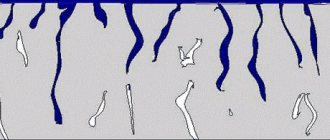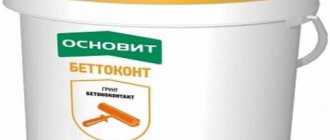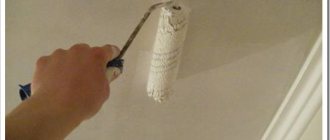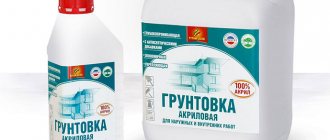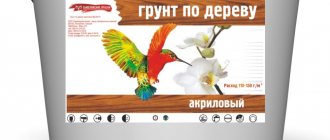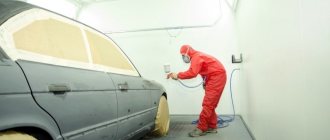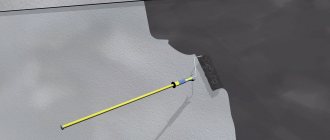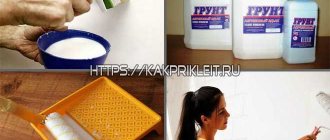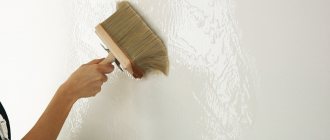How to fight fungus?
To destroy mold, you need to clean the room from moisture and dampness, treat it with special antiseptics, which contain aggressive chemicals that effectively remove mold. Such products can be purchased at any store. They are available in the form of liquids, sprays, and concentrates. When working with such powerful tools, you must follow safety precautions: wear work clothes, rubber gloves, a headscarf, and safety glasses. The chemical is applied to the walls and then removed along with the fungus. The best way to remove mold and prevent it from coming back is to scrape it down to the base of the wall and apply an antiseptic primer.
Home remedies can be used as alternative methods to combat mold. It is advisable to combine both substances with a mechanical method of removing fungus. It would also be a good idea to install a forced exhaust ventilation device and eliminate voids in the walls.
Briefly about the main thing
Any remedy for mold and mildew on walls works the same way: one penetrates the structure of the material, kills the pathogenic microorganism and prevents the damage from spreading further. There are a large number of chemical preparations and solutions that can be prepared from vinegar, chlorine, and hydrogen peroxide. Their use can eliminate the problem of the appearance of unattractive black spots, but without eliminating the causes of their occurrence, the fight will be pointless. The fungus will appear again and again, posing a threat to human health.
ANTIFUNGAL (CONCENTRATE FOR PROTECTION AGAINST BIOCORROSION) CERESIT CT 99
Antifungal agent (concentrate for protection against biocorrosion) Ceresit CT 99 for work inside and outside buildings. Extends the service life of structures, eliminating the risk of destruction due to biological factors.
Benefits of an antifungal agent
The material is environmentally friendly and can be used in premises for any purpose. The use of Ceresit CT 99 guarantees a positive result not only on new structures, where it prevents the appearance of mold and fungi, but also on those affected by biocorrosion. Here the material additionally exhibits its fungistatic properties - it destroys already formed colonies and prevents the development of new organisms from spores.
Additional benefits of the concentrate:
- the design does not require additional treatment of the affected areas for a long time;
- maximum penetration depth among analogues;
- absence of heavy metals.
After applying Ceresit CT 99, surfaces can be decorated and painted.
Using Ceresit CT 99
Ceresit CT 99 is a concentrate that needs to be diluted with ordinary water before use. The product is applied to horizontal or vertical surfaces with a wide brush, or a roller can be used. The material is economical, since dilution is carried out depending on the degree of contamination of the structure with biocorrosion.
ANTIFUNGAL AGENT (CONCENTRATE FOR PROTECTION AGAINST BIOCORROSION) CERESIT CT 99 – Characteristics
Viability of the finished mixture:
organic biocides solution
polymer bottle 1 kg
Density of the finished mixture:
What is suitable for wall treatment
All products are generally divided into two types: for wooden and mineral surfaces.
Antifungal agents for wood
This material is more susceptible to the appearance of fungus than others. Therefore, special attention should be paid to eliminating mold when working with wood.
How to treat wooden walls against fungus and mold before wallpapering:
- Dufa holzlasur is a product based on alkyd resin. The water-repellent coating protects new wood and restores old wood. Suitable only for external wall surfaces; it contains very harmful components. Has an unpleasant pungent odor. Each layer dries for 4 hours. It is difficult to pre-calculate material consumption. There are several types of shades.
- Baramon c30 is an odorless concentrate. It is diluted with water in a ratio of 1:6, respectively. Use only on impregnable types of wood. Dries within 2 days, during which time water should not get on the surface. The result is a crystallized leave-in substance. It will help get rid of mold and mildew forever. Indoors per square meter you will need 200 ml of product, outside - 300 ml.
- Pinotex Base is an alkyd antiseptic that improves adhesion to paints and glue. It is used on fences, facades, interior walls and any wooden products before painting or wallpapering. Suitable for work at 5-25 degrees. Used in its pure form, dries within a day. For 1 sq. meter you will need 4-8 liters of the drug. It depends on the properties of the material. Before use, you need to determine the wood moisture content, which is less than 20%.
If you do not treat wooden coverings with anti-mold preparations, they will deteriorate very quickly.
Primers for mineral surfaces
Apply a primer to the walls at the initial stage of finishing. This will help prevent mold growth.
How to treat walls against mold and mildew on mineral surfaces before wallpapering:
- Milkill is a white latex emulsion with the main active ingredient being a biocide. Eliminates many types of fungus. Suitable for the prevention of concrete, brick and similar walls. You will need 250 grams per square meter for one layer, a total of 2-3 layers are needed. Penetrates half a centimeter and dries in 24 hours. The unpleasant smell goes away after drying. It separates, you need to stir thoroughly. Used at temperatures from 5 to 30 degrees.
- Acryl Grundierung is a deep acrylic-based primer. Improves adhesion to finishing materials: plaster, paint. At 15 sq. meters you will need a liter of product. Reduces the amount of finishing materials by reducing wall absorption. All water-based paints and varnishes can be used over this preparation. Dries in 24 hours, suitable for work at 5-35 degrees. This product should not be poured down the drain.
- Shimmelstopp Dufa differs from others in that it is added to plaster, varnish or paint. Provides long-term protection against algae, fungus, and mold. They work with it at 5-30 degrees. It dries depending on the type of finishing material. One package is enough for 25 kg of plaster and 10 liters of water paint. The mixture of finishing and this product is thoroughly mixed.
- Mixonit gr43 is added to dry building compositions. Recommended for surfaces that absorb moisture well. Penetrates 10 cm inside, has no odor, and allows steam to pass through well. You will need 1 or 2 layers. Cannot be applied to non-absorbent walls. Reduces the amount of paint and varnish materials, but only dry surfaces can be painted. Dry coating can withstand a lot of freezing.
Advice: work with any chemical in a well-ventilated area. Wear goggles, gloves and a protective mask. Then harmful substances and fungal spores will not get into the lungs or onto the skin. Each working tool must be washed well after work.
Rules for chemical processing
When choosing a control method, it is important to remember that any of the listed remedies in their pure form can harm human health.
Therefore, before work you need to protect yourself: put gloves on your hands, cover your face with a respirator or mask. The rules for using the drug are described in detail by the manufacturer in the instructions. It is important to follow them during application. The technical data sheet of the composition indicates the dosage that can destroy the fungus. You cannot experiment with changing it.
Personal protective equipment for treating walls with antiseptic compounds Source lkmprom.ru
Usually, before work, the product is diluted with water and then applied to the affected area. To work, you may need a construction trowel, a stiff brush, a roller or a sprayer. Before applying the drug, the area must be cleared: remove the coating. The fungus first affects the upper layers; it spreads especially quickly inside walls covered with plaster. It penetrates through it and forms a branched mycelium. Therefore, first you need to completely remove the coating material with a spatula, and only then begin to “poison” the fungus. Typically, you leave the mold remover on the walls until it dries.
How to remove fungus-affected trim from wallsSource cleanadvice.ru
If the problem is not resolved the first time, you will have to re-process it. After the base has dried thoroughly, it must be coated with an antiseptic primer and re-plastered with cement mortar, after which the surface should be covered with a waterproofing compound. Then it will be possible to prevent the occurrence of “relapses”. The right anti-mold paint on the walls will look good. Its layer will protect against moisture penetration and will not allow fungal spores to penetrate deep into the finish again.
When wallpaper pasted on a concrete base is affected, you need to remove it completely, carefully remove the black deposits with a spatula, and only then treat the area with antiseptics. It is best to use deep penetration formulations for this. They are absorbed into the porous structure of concrete, kill the fungus and stop its spread. You can begin cosmetic repairs only when the antiseptic has completely dried.
Wallpaper with mold growing under it must be removed Source www.propertydamageconsultants.com
Mold-infected plasterboard sheathing will also have to be completely dismantled and thrown outside
It is important to carefully inspect the sheathing after dismantling. The absence of traces of its damage does not allow one to refuse preventive disinfection
This is more relevant when the sheathing is assembled from wood. If you thoroughly saturate all the planks with wood preservative, you can reinstall the drywall.
